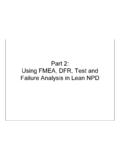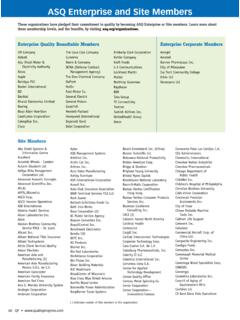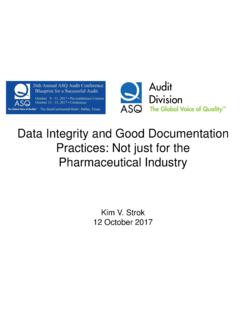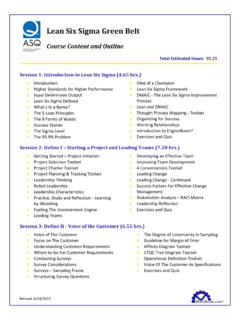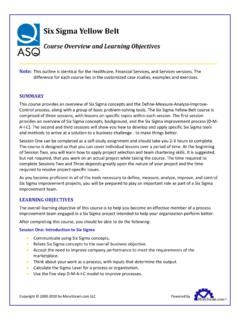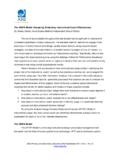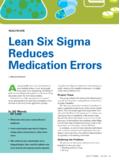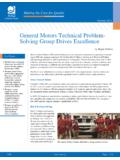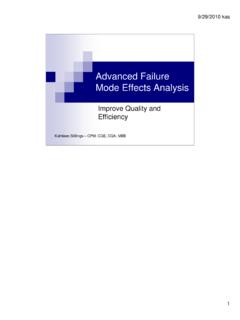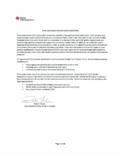Transcription of Improving Efficiency and Effectiveness of FMEA Studies
1 Contents Executive Summary .. 2 Benefits of conducting effective FMEA Studies .. 2 FMEA challenges created by lack of clarity .. 3 Planning Defining the scope of the study .. 3 Planning Identifying the team ..4 Structuring the approach & managing time ..4 Leveraging existing knowledge .. 6 Continuous improvement & action follow-up .. 6 Additional post-study challenges .. 6 Meeting challenges through Efficiency , structure and automation .. 7 The spreadsheet approach .. 7 Preferred solution for efficient and effective FMEA Studies .. 7 Conclusion .. 8 About QA Assistant 8 Web: | US Phone: (1) 978-631-0424 | EU Phone (UK): +44 (0)20 881 6767 8 | EU Phone (IE): +353 (0)1 443 4322 Improving Efficiency and Effectiveness of FMEA StudiesPage 1 Executive Summary This paper discusses the challenges engineering teams face in conducting Failure Modes Effects Analysis (FMEA) Studies and the best practices for meeting those challenges.
2 This paper focuses on the specific topic of Improving the Efficiency and Effectiveness of FMEA Studies . Modern economic needs and increased business competition require engineers to constantly develop newer and better solutions within shorter timeframes and tighter margins. In addition, documentation requirements for meeting standards / regulatory compliance and customer needs are becoming increasingly complex and verbose. Managing open actions and continuous improvement activities across all projects, product variations, and processes in addition to daily engineering tasks is cumbersome, time consuming, and is susceptible to errors, omissions, and non-conformances. FMEA Studies are proven methods for Improving products and processes while subsequently reducing engineering workload and Improving machine and resource availability through a preemptive, systematic approach of identifying, analyzing, and Improving high-risk components.
3 If implemented correctly, FMEA Studies significantly reduce costs and improve productivity. However, the value of an effective FMEA is often shrouded by a lack of clarity and structure, misconceptions, and previous experiences and, as such, FMEA Studies are frequently grouped with the other required information and documented retrospectively in preparation of customer requirements or audits. Performing Studies in this way only adds cost to a project and perpetuates the misnomer that FMEA Studies are not value-added paper discusses the benefits of effective FMEA Studies , the challenges related to conducting FMEA Studies , best practices for efficiently overcoming challenges via structure and automation, and the benefits of implementing those of conducting effective FMEA Studies The goal of completing effective FMEA Studies is to improve products and processes through a systematic approach of reducing risk and the limiting opportunities for product/process failure.
4 Effective FMEA Studies are powerful tools that benefit the organization, customers, and end users by: Improving yield and profit margins Reducing time to market Increasing machine and human resource availability Ensuring employee and customer safety Meeting industry specific standards compliance and customer requirements FMEA studiessignificantly reduce costs and improve productivitywhen properly : | US Phone: (1) 978-631-0424 | EU Phone (UK): +44 (0)20 881 6767 8 | EU Phone (IE): +353 (0)1 443 4322 Improving Efficiency and Effectiveness of FMEA StudiesPage 2 Identifying necessary controls and developing test procedures Supporting due diligence claims in legal disputes Completing FMEA Studies efficiently has the additional benefits of freeing up valuable engineering time, reducing the cost of quality , and most importantly, obtaining the team buy-in which likely ensures Studies will be conducted more regularly and helps drive continuous improvement activities.
5 As well as being a reliable tool for preventing potential risks in the subject design or process, the process of developing an FMEA provides the environment to identify improvements for similar designs and processes. Cost savings across multiple product lines may be realized while conducting a single FMEA study. FMEA challenges created by lack of clarity While developing products and processes, engineers instinctively plan for potential physical and financial risks which may jeopardize a design. Although FMEA is simply a method for engineers to document their thought process and the FMEA s logical flow itself lends naturally to the engineering environment, there is still a reluctance and tendency to postpone FMEA Studies ; But why? Planning Defining the scope of the study The FMEA process can be daunting and out of the comfort zone for engineers.
6 FMEA documents created after a project is complete may expose weaknesses in the product or process design which is frustrating for the team who invested so much defined document scopes, unsuitable team selection, anda general misunderstanding of the FMEA process also contribute to weak study results and a discouraged team. An FMEA study s timing and clear scope play a critical role in its success. Conducting the FMEA prior to a project and reviewing it as the project progresses will save your team time, help reduce development costs, and will be seen by the team as a value-added support rather than a hindrance. In the past, FMEAs were expected to be an extensive document detailing every aspect of a product design or process.
7 In the modern approach , there is far more flexibility in the functionality of the study. Existing family level FMEA documentation, for example, may address a broad range of products or processes. Certain components of the product or aspects of the process which are considered extremely low-risk or trivial may be unnecessary to detail. Therefore, the scope of the FMEA may be defined to focus only on potential high-risk aspects of the design or process such as a new technology, safety critical features, or complex components which merit additional thought and preparation. Defining a An FMEA study s timing and clearscope play a critical role in its : | US Phone: (1) 978-631-0424 | EU Phone (UK): +44 (0)20 881 6767 8 | EU Phone (IE): +353 (0)1 443 4322 Improving Efficiency and Effectiveness of FMEA StudiesPage 3manageable scope will gain team support and help focus efforts on the areas of greatest concern.
8 Planning Identifying the team The document scope plays an integral role in determining the appropriate team. While an FMEA team may include representation of the customer requirements, key disciplines involved in the product or process design and implementation, test engineering, reliability engineering, and/or quality engineering, only people directly involved in the product or process in the scope of the FMEA should be involved in its creation. "The more; the merrier" is not an applicable phrase when it comes to selecting an FMEA team. If a team has too many members, it may limit individual contributions and inspire impertinent conversations which removes focus from the task at hand and leads to longer study completion times.
9 Before an FMEA revision or version is finalized, consider sending it to the team members for approval. Including the team in the approval process gives ownership of the document to the team, reminds relevant team members of open actions, and demonstrates to the team that their input is the approach & managing time Even with a properly defined document scope and a well assembled team, a significant amount of time is often lost during the brainstorming process when the team is researching and documenting the information for the study. The researching process is often unstructured, manual and dependent solely on the experiences and expertise of the current team entry may also betedious and slow using traditional spreadsheet templates.
10 Structured approach An unorganized approach to an FMEA study ( filling in fields in a random order, poor preparation, etc.) leaves the study vulnerable to erroneous or incomplete information. Even if a systematic approach is adopted, the selected method plays an instrumental role in the team s performance quality, quantity, and demonstrate the variance in potential productivity depending on the chosen method, consider the following table. If the table is completed one item at a time, entering the size and color before moving on to the next item, the thought process must shift from column to column which slows down the pace of the document. To illustrate the amount of time it takes, complete the table below using this first method entering a vegetable, its size, its color; then enter another vegetable, its size, and its color; and so on.

